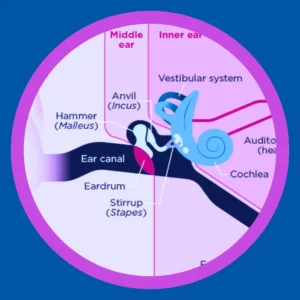Conductive vs. Sensorineural Hearing Loss
Hearing loss touches nearly every family. It affects conversations, work, safety, and confidence. Yet not all hearing loss is the same. Compare the two most common types, conductive hearing loss vs. sensorineural hearing loss. Knowing how they differ helps you understand your own hearing health and choose the best care.
This guide explores conductive vs. sensorineural hearing loss in detail. You will learn about symptoms, causes, diagnosis, treatment, and prevention. We’ll also cover special cases such as mixed hearing loss and sudden hearing loss, two conditions that deserve special attention.

How the Ear Works and Where Hearing Problems Begin
Your ears are small but complex. Each part has a role in carrying sound to your brain.
- Outer ear: Collects sound and channels it to the eardrum.
- Middle ear: Amplifies sound with three tiny bones called ossicles.
- Inner ear: Converts vibrations into electrical signals with delicate hair cells.
- Auditory nerve: Sends signals to the brain for interpretation.
If any of these parts stop working correctly, hearing changes. Conductive hearing loss affects the outer or middle ear, where sound is carried inward. Sensorineural hearing loss affects the inner ear or auditory nerve, where sound is processed and sent to the brain.
Symptoms and Causes of Conductive vs. Sensorineural Hearing Loss
People often wonder how to tell the difference between the two types. Both reduce hearing ability, but they do so in different ways. Conductive hearing loss usually makes sounds softer, like turning down the volume. Sensorineural hearing loss makes sounds less clear, like trying to tune in a fuzzy radio station.
Here is how their symptoms and causes compare.
| Aspect | Conductive Hearing Loss | Sensorineural Hearing Loss |
| Common symptoms | Ears feel plugged, muffled hearing, pressure, pain with infections, dizziness | Trouble understanding speech, high-pitched sounds fade, difficulty in noisy settings, tinnitus, unclear voices |
| Typical onset | Sudden or gradual depending on cause | Usually gradual, but sometimes sudden |
| Causes | Earwax buildup, outer ear infection, fluid in the middle ear, eardrum perforation, otosclerosis, cholesteatoma, foreign object in canal | Aging, prolonged noise exposure, ototoxic medications, inner ear infections, autoimmune inner ear disease, head trauma, tumors, genetics |
How Providers Diagnose Conductive vs. Sensorineural Hearing Loss
You cannot guess your type of hearing loss without testing. Hearing care providers use several tools to find the cause.
- Physical exam: Checks for wax, fluid, or infection.
- Tuning fork tests: Simple in-office tools that suggest whether the problem is conductive or sensorineural.
- Tympanometry: Measures eardrum movement and middle ear pressure.
- Audiogram: A full hearing test that maps your thresholds across pitches.
On an audiogram, conductive hearing loss appears as an “air-bone gap.” Sensorineural hearing loss shows reduced thresholds with no gap, and often reduced word clarity. These results guide treatment decisions.

Treatment Options for Conductive vs. Sensorineural Hearing Loss
Treatment depends on the type of loss. Conductive hearing loss often responds well to medical or surgical care because the problem is mechanical or physical. Sensorineural hearing loss usually requires technology support since the inner ear cannot repair itself.
| Treatment | Conductive Hearing Loss | Sensorineural Hearing Loss |
| Medical care | Earwax removal, antibiotics, decongestants, allergy treatment | Sometimes steroids for autoimmune or sudden loss |
| Surgical care | Eardrum repair, tubes for chronic fluid, surgery for otosclerosis or cholesteatoma | Rare, usually only for tumors |
| Hearing aids | Helpful when the problem cannot be fully corrected | Primary treatment for most cases |
| Bone-anchored devices | Often used if middle ear cannot conduct sound | Less common |
| Cochlear implants | Rare | Common for severe or profound cases |
Prevention Strategies for Long-Term Hearing Health
Not every type of hearing loss can be prevented, but many risks can be reduced. Simple steps protect your hearing health.
To reduce conductive hearing loss risks:
- Treat colds and allergies as directed by your doctor.
- Avoid inserting cotton swabs or objects into your ears.
- Have wax removed professionally if it builds up often.
- Address ear infections quickly, especially in children.
To reduce sensorineural hearing loss risks:
- Wear earplugs at concerts, sporting events, and while using power tools.
- Keep music and podcasts at safe listening levels.
- Limit daily exposure to loud noise.
- Ask your doctor about potential medication side effects.
- Schedule routine hearing tests to track changes early.
Mixed Hearing Loss: When Both Types Appear Together
Some people develop both conductive and sensorineural hearing loss in the same ear. For example, an older adult with age-related hearing loss might also have middle ear fluid. This combination is called mixed hearing loss.
Treatment usually requires a two-part plan. Medical or surgical care may improve the conductive part, while hearing aids or implants support the sensorineural part. Correct diagnosis is important so both issues are addressed.
Sudden Hearing Loss: Why It Requires Immediate Care
Not all hearing loss happens slowly. Sudden sensorineural hearing loss can occur within a few days, often in one ear. It may be linked to viral infections, circulation problems, or unknown causes.
This condition is a medical emergency. Prompt treatment, usually with steroids, improves the chance of recovery. If you ever notice sudden hearing changes, do not wait. Contact a professional right away.
How Hearing Aids Improve Everyday Communication
Even when hearing loss cannot be reversed, today’s hearing aids restore confidence and connection. They amplify important sounds, reduce background noise, and connect directly to phones and TVs.
Rechargeable models simplify daily use. You can learn more in this guide to rechargeable hearing aids.
Many people wonder if earbuds can replace hearing aids. The truth is that earbuds are not medical devices. For a full comparison, see this overview of AirPods vs. hearing aids.

Why Professional Hearing Care Is Essential
Getting the right care starts with choosing the right provider. A professional will test your hearing, explain your results, and design a plan tailored to your needs. For tips, see this article on finding the best audiologist near me.
Insurance and Medicare coverage may also affect your decision. For details, visit this guide on understanding Medicare hearing aids coverage.
Frequently Asked Questions About Hearing Loss Types
Can conductive hearing loss go away on its own?
Yes, sometimes. Wax buildup, minor infections, and small eardrum perforations can resolve. Always get checked to avoid complications.
Is sensorineural hearing loss reversible?
Most cases are permanent. Some sudden or autoimmune-related cases improve with treatment, but aging and noise damage cannot be reversed.
How can I tell which type I have?
Only a hearing test can confirm the type. Symptoms give clues, but professional testing is essential.
Do both types cause tinnitus?
Yes, but tinnitus is more common with sensorineural loss.
Are children at risk for both types?
Yes. Kids often develop conductive loss from ear infections, while some are born with sensorineural loss due to genetic factors.
Can hearing aids help both types?
Yes. For conductive loss, they help when medical options are limited. For sensorineural loss, they are the main treatment.
It’s Time to Check Your Hearing
Hearing loss comes in many forms, but solutions are available. Conductive hearing loss often responds to medical care. Sensorineural hearing loss usually benefits from hearing aids or implants. Mixed hearing loss and sudden hearing loss need special attention but can also be managed with the right support.
The most important step is getting tested. A clear diagnosis opens the door to better hearing and a better quality of life.
Contact Stanford Hearing today to schedule your appointment and start your path to clearer sound.
